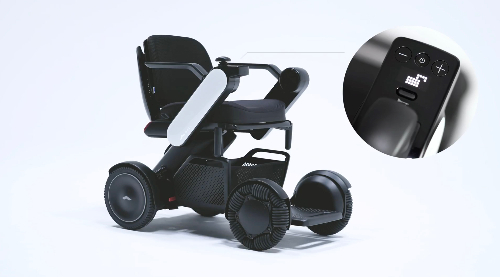J-STORIES - As some countries, including Japan, deal with the challenges of aging and shrinking populations, attention has turned to the development of “wearable” robots. Not only can these devices support and strengthen motor functions that have declined with age, they can reduce physical demands on workers in a range of fields, such as medical care, caregiving, manufacturing, construction and logistics.
But as wearable robots become part of our everyday lives, is there a way to make them lighter and easier to use? That is the aim of Minoru Hashimoto of the Faculty of Textile Science and Technology, Shinshu University. His team is developing a wearable robot that can provide power to the body while being as light as an ordinary item of clothing.
In 2017, Hashimoto established a startup named AssistMotion. The “curara” robot it developed is already in use at hospitals and care homes, and has been available to the public for rent since 2022.
Typically, wearable robots have been developed to reduce the physical demands on those working in logistics, nursing care and other fields. Curara, on the other hand, is designed to help those who have trouble walking due to aging, illness or accident. The robot’s name comes from the children’s novel "Heidi" by Johanna Spyri, and is also a popular Japanese anime television series. In the story, Heidi’s friend Clara (curara in Japanese) is able to stand up from her wheelchair and start to walk again.

Conventional wearable robots have their own exoskeleton and are designed to support the whole body, and because of this weigh around 15 kilograms. However, the full-set controller version of curara, which covers four joints, weighs 2.9 kilograms, while the half-set type, which covers two joints, weighs just 1.8 kilograms.
Curara is a “non-exoskeleton” wearable robot with motors attached near the body’s joints. It follows the body’s movements providing additional power, so does not require a framework to support itself. And because it is relatively light, it is easy to take off and put on.

Developed with the aid of textile research, it is similar to an item of clothing and moves easily. The robot’s weight is supported by belts around the waist and legs, and there is no need to attach electrodes to the wearer’s body. According to Hashimoto, it can be used in physiotherapy to increase walking speed, lengthen strides and improve balance between the left and right sides of the body.
Compared to real joints, exoskeleton joints have limited mobility. For example, a human hip joint can rotate as well as move left and right, whereas a typical robot joint can only move back and forth. But in curara’s case, the robot matches the human wearer’s movements, making walking possible.
“The person isn’t forced to adapt to the robot. The robot adapts to the person’s movements,” says Hashimoto.

One reason Hashimoto decided to develop curara was to make use of expertise at Shinshu University’s Faculty of Textile Science and Technology, whose researchers could create a robot that was similar to an item of clothing and comfortable to wear.
Another reason was his mother, who entered a care home around 10 years ago.
“Up to that point my mother had been able to walk by herself, but within a year she was given a wheelchair. With fewer chances to walk, walking became difficult for her,” he says. Hashimoto believes that had his mother been given chances to walk, she’d still be able to walk today.
Currently, curara is mainly used by people with neurological disorders, hip fractures, and those undergoing physiotherapy. But the next step is to market a new robot that can help the elderly with daily activities as well as walking. The challenge is to bring down both the robot’s weight and cost.

Hashimoto says that he’d like to develop a robot that could help seniors or people carrying children cross the road while the light is still green. Such a robot would require the development of new functions, such as assistance with standing up, sitting down, and going up and down stairs and slopes.
The four-joint full curara costs 1,749,000 yen (including tax), making it difficult to market to the general public. In future however, Hashimoto hopes to offer it as a low-cost welfare product that is covered by Japan’s long-term care insurance system.
MotionAssist is also looking at new applications, such as a smaller wearable robot that would fit children between 90 and 145 centimeters tall. Potentially, this could help children with cerebral palsy or spina bifida who have been unable to walk since birth. The system is being developed together with Nagano Children’s Hospital, with demonstration tests planned for this year and practical use next year.
The company also has plans for overseas expansion two years from now. There is particular potential in Southeast Asia, where care and treatment are often provided to people from overseas as well as locals.
Translation by Tony McNicol
Top page photo by AssistMotion
For inquiries about this article, please contact jstories@pacficbridge.jp
***
Click here for the Japanese version of the article
_smallthumbnail.jpg)



![[Podcast] Japanese technology to supercharge human fertility (Part 3)](https://storage.googleapis.com/jstories-cms.appspot.com/images/1766558713084place-for-scientific-research-2025-03-07-14-08-49-utc%20(1)_bigthumbnail.jpeg)
![[Interview: Part 2] A digital approach to tackle child hunger in Japan with dignity](https://storage.googleapis.com/jstories-cms.appspot.com/images/1766130666509unnamed_bigthumbnail.jpg)
![[Podcast] Japanese technology to supercharge human fertility (Part 2)](https://storage.googleapis.com/jstories-cms.appspot.com/images/1765863548035unnamed-7_bigthumbnail.jpg)
![[Podcast] Japanese technology to supercharge human fertility (Part 1)](https://storage.googleapis.com/jstories-cms.appspot.com/images/1765440905082unnamed_bigthumbnail.jpg)
_bigthumbnail.jpeg)





![[Interview] When digital and physical worlds meet](https://storage.googleapis.com/jstories-cms.appspot.com/images/1747974430456unnamed-2_smallthumbnail.png)




_smallthumbnail.jpeg)

![[Interview: Part 1] From nourishing souls to feeding the hungry](https://storage.googleapis.com/jstories-cms.appspot.com/images/1763695595492unnamed_smallthumbnail.jpg)


Awsome